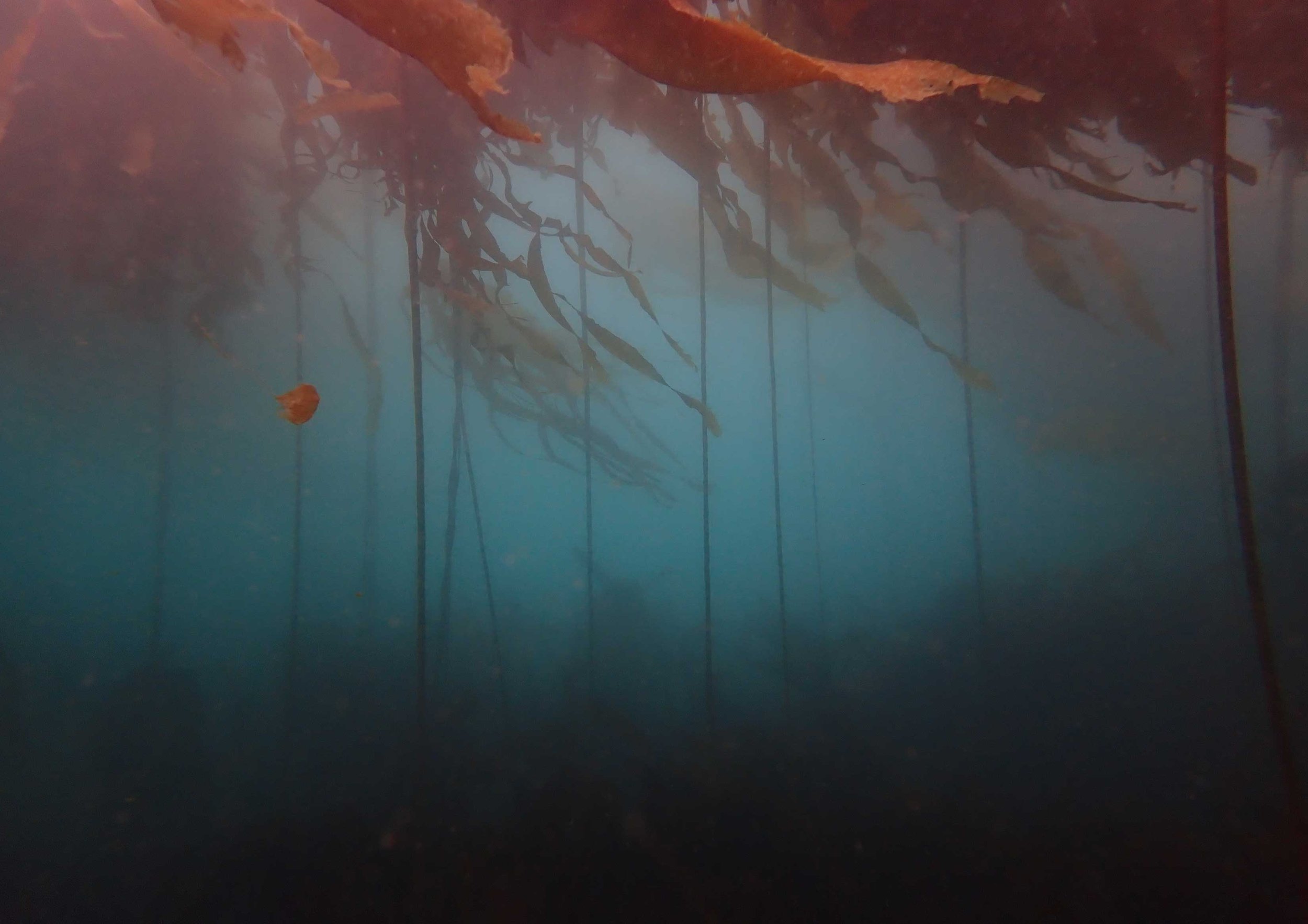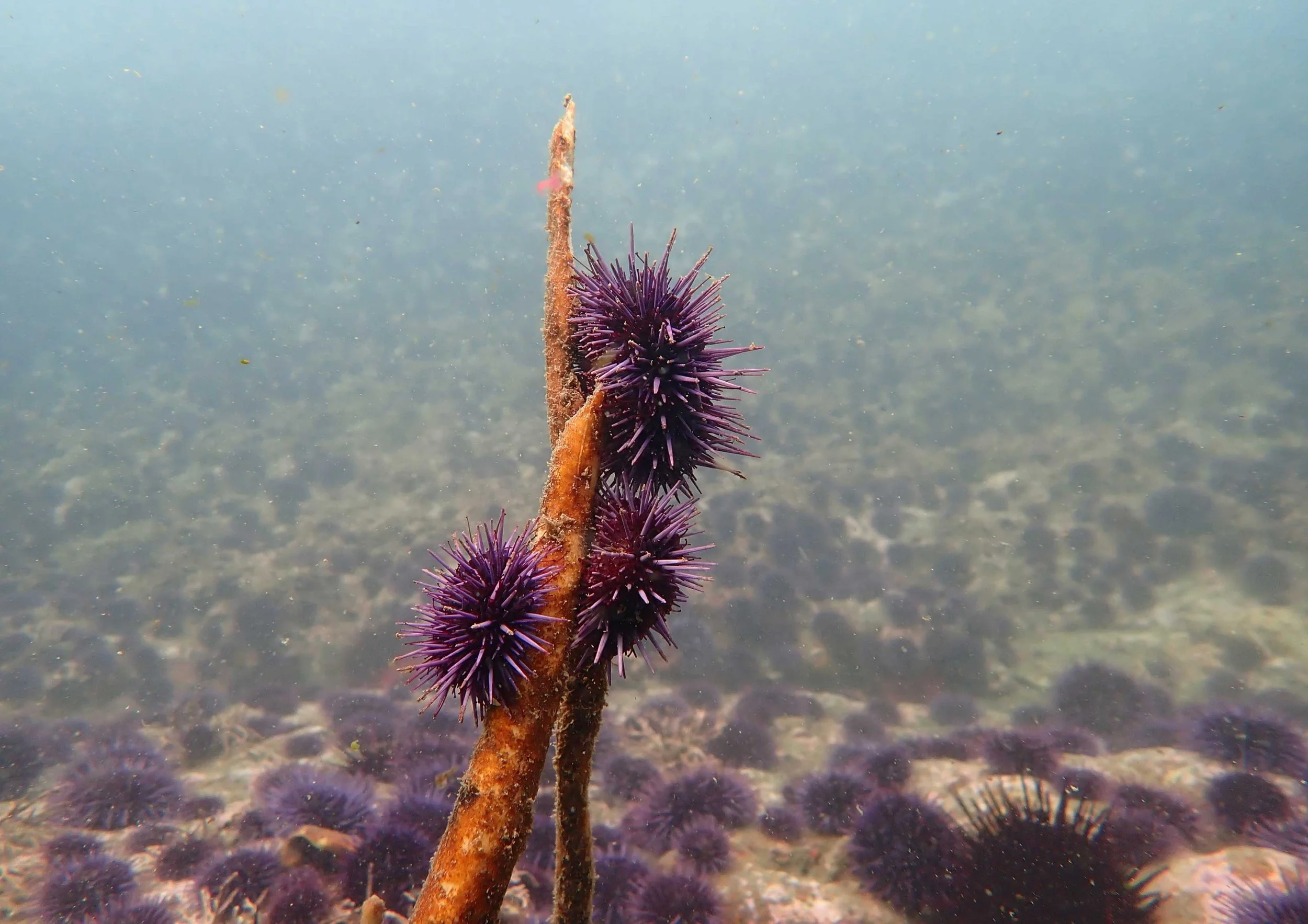
What's Up with Kelp?
Redwoods of the Ocean
Bull Kelp (Nereocystis luetkeana) is the majestic kelp that grows up to sixty feet in one season, to reproduce and be washed away by winter storms each year. It is the signature species making up the vastly productive kelp forests of the Northern Pacific coastline from Central California through Northern California, the Pacific Northwest, British Columbia, Alaska, and halfway through the Aleutian Islands. It is the kelp within which herring school and spawn, rockfish abound, seals seek prey and refuge from sharks, and young salmon adapt to their salty home. It is the canopy under which countless other seaweeds grow including the understory kelps and pink rock-encrusting coralline algae that attract the settling of urchin and abalone and young bull kelp. Under the gestural swaying largess of the bull kelp is a colorful world with sea stars and nudibranchs and sponges. There are also other large kelps in the mix—Macrocystis pyrifera, or giant kelp, which dominates the kelp forests south of Monterey clear to Mexico. But from Central California to Alaska, bull kelp is the major player, massive and hefty, thriving in the nutrient-rich, cold waters of the Northern Pacific. It is the pride of the North Coast of California. Known as cʰanamáby the Pomo, it usually thrives in the dynamic, wave-churned waters, with great heaps of tangled wrack thrown onto the beaches and coves every year when these ocean forests are healthy.
Kelp Abundance Until 2014
The bull kelp forest once supported various dynamic fisheries along the Mendocino and Sonoma coast including the red urchin fishery where divers walk (SWIM) the ocean floorcollecting the larger urchin for the uni market. The recreational abalone fishery along the North Coast was legendary, until it was closed in December of 2017. Both urchin and abalone feed on kelp—they are herbivores—typically subsisting on the detritus from kelp as it sinks to the seafloor. The crab, rockfish, and salmon also depend on healthy kelp forests for increased abundance.
And then it went away. Sea star wasting disease was first detected at the end of 2013 and felled all sea stars on the west coast during the years of 2014 and 2015. Millions of sunflower sea stars, before now unassuming in its role as purple urchin predator, vanished from the waters. Research suggests that as many as 5.75 billion animals died from the disease (Gravem et al. 2021, Hamilton et al. 2021) and we just found out the causative agent is Vibrio pectenicida (Prentice et al. 2025).
Simultaneously an ocean heat wave, known as “The Blob,” plus an El Niño event, parked a large mass of warm water offshore raising the surface temperatures by as much as 2.5 degrees Celsius—a huge amount. The third event, surmised to be a result of the previous two, was an explosion in native purple sea urchins. And these hungry urchins, with no predators, are eating the kelp. Lots of it. Kelp canopy mapping and monitoring have shown a greater than 96% loss in bull kelp canopy throughout the Mendocino and Sonoma coasts as of 2023. The ramification of this kelp loss goes deep into the community with closed fisheries, loss of legacy dive shops and the loss of an ecosystem highly valued by a coastal community deeply rooted in kelp.
But things are changing, With help from an amazing team of kelp recovery experts, a couple of years of cold ocean temperatures, the kelp at Big River is coming back!
Kelp Loss Over Time
This map shows the rapid loss of kelp off of Portuguese Beach at Big River by Mendocino, California from 2020 - 2024.
Location of experimental restoration site with high resolution 3 cm drone kelp canopy data from 2020-2024. Light green shades show the kelp canopy extent before urchin barren encroachment, while dark green shades show the kelp canopy shrinking after the encroachment. The pink canopy area shows kelp canopy expansion and protection following the initiation of restoration activities. While Northern California has lost 96% of its bull kelp canopy since 2015, the Portuguese Beach (Big River) kelp bed was resilient to the initial decline and was even considered kelp refugia. However, since 2022, we have observed about 84% decrease in kelp canopy at this core site. In 2023, we saw the most drastic decline in kelp at Big River.
While Northern California has lost 96% of its bull kelp canopy since 2015, the Portuguese Beach (Big River) kelp bed was resilient to the initial decline and was even considered kelp refugia. However, since 2022, we have observed about 84% decrease in kelp canopy at this core site. 2023 saw the most drastic decline in kelp at Big River, and is when recovery efforts began. Since then kelp recovery has been mapped and recorded and observed by scientific divers, walkers of the Mendocino bluffs as well as fish, birds and the biodiversity that has returned to some quadrants of the Big River kelp beds.
Portuguese Beach Kelp Forest Decline
2020
2021
2022
“I have been diving Big River since 2018 and this was four years after declines of kelp began. Big River was our ‘not all is lost’ site. But then, in 2022, a major decline in kelp there was detected. When the OPC/Sea Grant call came out, we knew this was our shot to bring brilliant people together and put our best and boldest strategies for recovery forward and get state support for kelp recovery efforts on the North Coast.”
– Tristin McHugh, Kelp Project Director, The Nature Conservancy
Kelp Recovery at Big River
Part of the 4% remaining kelp was, for many years, at the mouth of the Big River at Portuguese Beach. This was a refuge, a productive, glorious bed of remaining bull kelp right off the cliffs at the town of Mendocino. But then in 2020 a major decline in kelp there was detected. Urchin were attacking the kelp at this stronghold of kelp resilience at an alarming rate. Tristin McHugh at The Nature Conservancy sprang into action. She led a collaborative team in the writing of a proposal for State funding to bring together the research and people doing experimental restoration and community building work. The project team includes locals to Mendocino as well as the folks working in marine labs up and down the North Coast who are perfecting techniques for breeding and outplanting “baby kelps” via microscopically inoculated substrates underwater, including urchin divers, underwater surveyors, and technicians. Together, this team has aligned in motivations and approach to reforest this highly important kelp refugia location to support a thriving coastal ecosystem and community.
In December 2023, The Nature Conservancy was awarded a 1.6 million dollar grant to advance an integrated approach to kelp recovery, using a combination of techniques used in prior projects. This is exciting work, which involves:
harvesting urchins from the recovery site and support programs that their use as food, dye, ceramic kiln and more
outplanting microscopically inoculated twine on ropes underwater
diving instruction for a new community of divers to help the program
hosting KelpFest! in 2024 and 2025 to educate and engage the community in these kelp recovery efforts
In other words, it will involve YOU! The community is highly motivated to facilitate revival through coordinated, grassroots recovery efforts that are holistic in approach.
Read a detailed description of the
Kelp Restoration Project at Big River, Mendocino.
North Coast KelpFest!
A Place to Learn and Ask Questions
Every activity of KelpFest! is a place to learn about kelp generally and about the kelp recovery project specifically. We invite you to ask questions and learn how to get involved. Sign up for art workshops to learn about uses of urchin harvested from recovery sites. Eat delicious food made with seaweed, uni, and other wonders of the local ocean that are part of a Blue Economy on the North Coast. Be inspired by artwork that is in turn inspired by the bull kelp itself. Perhaps make some art yourself. In all cases come enjoy the glories of Mendocino County, the wonders of its coastal waters, and celebrate Kelp!
Dive deep into all things bull kelp with the web-based book The Mysterious World of Bull Kelp by Above/Below:
Review lessons learned from kelp restoration in this digital guidebook created by The Nature Conservancy:



